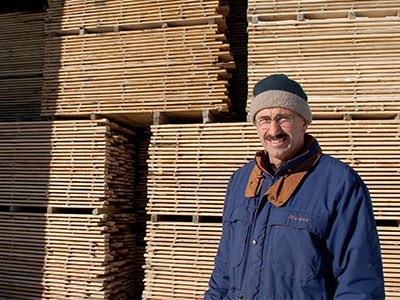Quality Hardwoods in Powassan is looking eastward for new markets. After surviving the lumber slump that started about five years ago, the company is finding new customers in Asia.
“In 2009, we actively started pursuing the off-shore market because China was starting to develop an appetite for North American hardwood in a bigger way,” said Pete Van Amelsfoort, operations manager. “They started using more oak and poplar from the U.S. and then they started looking further north.”
He attended a trade show in China last year, which had 50,000 visitors, and managed to acquire a couple of new accounts.
The company had one account already set up, and another had been acquired in 2011.
“Cost, price and quality are very much at the forefront. We are working with small margins and work directly as much as we can,” he said.
“We have a lot of limitations as far as transportation goes because with container costs to ship from here to a port in China, we are behind anybody on the Eastern seaboard in the U.S., so there is a disadvantage there.”
With a foothold in the market, Quality Hardwoods has shipped 55 to 60 containers so far.
“Coming from nothing to five or six years ago, we can’t complain,” said Van Amelsfoort.
Asian markets may not utilize as much solid hardwood in furniture as North Americans do, but it is used in accents and special pieces. There is also a huge potential for flooring and engineered flooring.
“We won’t be the only supplier, since Russia has a huge wood basket right next door,” he said.
The hardwood has been shipped to Sri Lanka, India, Pakistan, Vietnam, South Korea and China, in addition to England and Ireland. The domestic market still makes up the majority of sales.
Mills in the North and central Ontario supply the company.
Quality Hardwoods was hit hard by the recession in 2008, and the resulting slump in the lumber industry.
“Suddenly, in 2008, everyone hit a wall. The lumber market just imploded. If there were a healthy housing market in the U.S., there would be a three-month supply of new housing units. When the recession hit, it went to 12 months and foreclosures were just unbelievable,” Van Amelsfoort said.
“We were on our knees, along with everyone else in the lumber business.”
Its workforce was cut in half – from 30 to 40 to about 15 to 16 – and it went on a work share program for about a year-and-a-half.
“We lost some people to the mining industry,” he said. “But we are slowly coming back from that edge.”
At the same time the recession hit, owner Paul Brooks embarked on a million dollar project to convert its heating system from oil to wood pellets to save on fuel costs.
“Wood pellets saved us half the cost of oil. We get our pellets from a company in Hearst. We still use oil in forklifts and backup furnaces, but it was a cost that we had to manage. We just tackled it at a bad time, but there was no turning back,” Van Amelsfoort said.
The company started in 1994 by Brooks, which was just wholesale at that time. He wanted his own yard and facility, in order to have more control of the product.
“Back in 1995, we were just coming out of a recession and it was a bad one. American consumers were just starting to develop an appetite for hard maple and white woods, as opposed to oak and cherry which they had lots of in the U.S.,” he said.
“Back at that time the exchange rate was very much in our favour and when the first kiln was started, we had not developed any export markets. We were dealing mostly with the Toronto area, which was a big part of his market, and which was booming.”
When Quality Hardwoods started to process lumber, Brooks advertised in trade magazines and soon developed a customer base in the United States.
“That was our entry into the export market. At that time, we did get the odd inquiry from off shore, but China was just starting to develop. They were buying logs and not lumber, sawing them there, since labour was so cheap,” Van Amelsfoort said.
Over next 10 years, up until 2006, the American market was the big one for the company.
However, business is looking up and he expects there is a lot of pent-up demand in the U.S. for new housing.
“When dealing with Asian countries, we have to think lean and work that way to survive. I think that is true for all of us and that’s how we got through the past few years,” he said.




